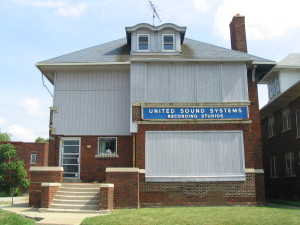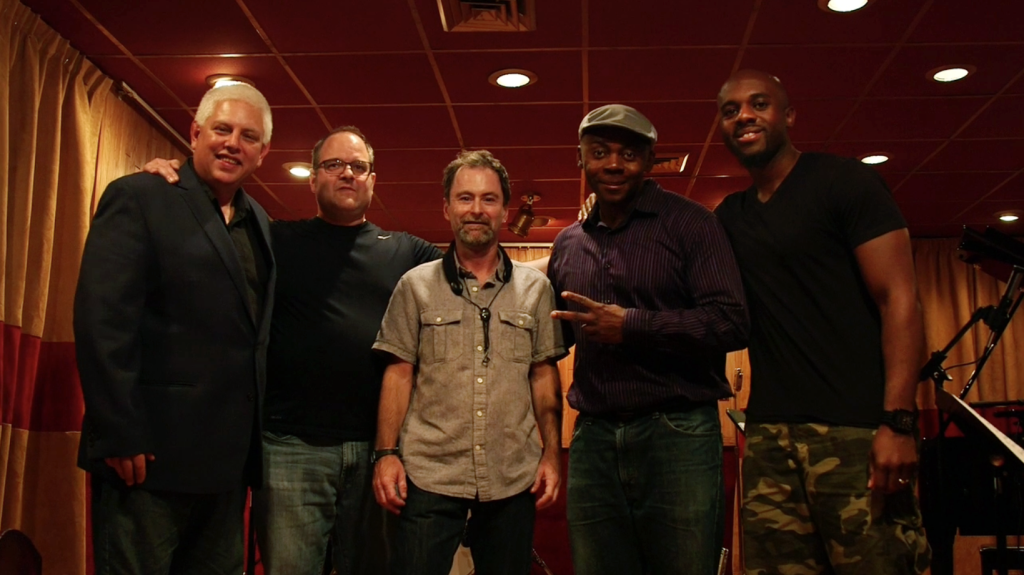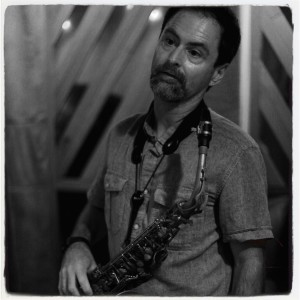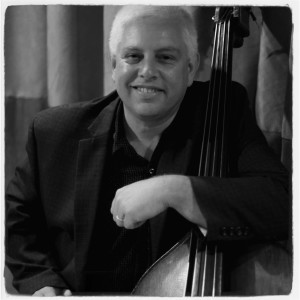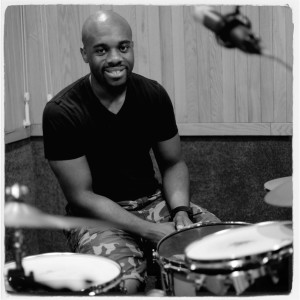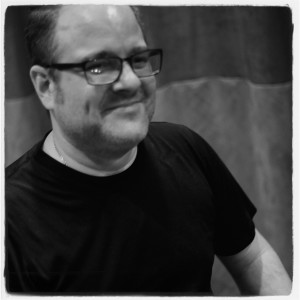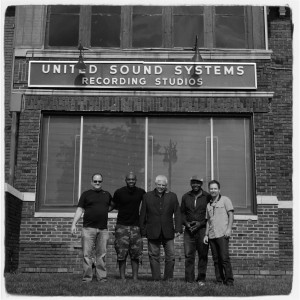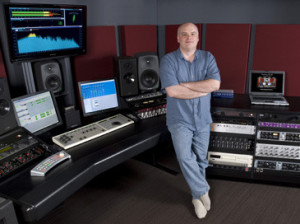Recreating Bird: Returning to Detroit’s Legendary “United Sound Systems” Recording Studio
A lot has changed in the recording industry since the 1940’s. The road from acetate masters to digital streaming has been a long one, and there are still music critics who feel that it is simply impossible to make recordings today that can deliver the same sound, feel and emotional impact of the tape or acetate releases of the past.
In the jazz world, labels like Verve and Blue Note are often noted for the groundbreaking work they did in the 1950’s and 1960’s. They stand as great reminders of how classic recordings from decades ago can remain so powerful today—and how sometimes, all the advances in technology that we take for granted only get in the way of pure creation.
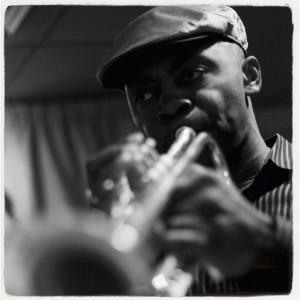
Trumpet player Dwight Adams invokes Miles Davis at a Detroit recording studio that was almost lost to time. Photo by Reggie Tiessen.
With that in mind, I recently worked to launch a new project in hopes of proving that it is possible to record in modern times, with modern technology, while capturing the unparalleled sound and feel of the past.
Our debut release at TQM Recording Co. brought us to the historic and recently-rescued United Sound Systems Recording Studios of Detroit, Michigan. The goal: To recreate the acoustic stamp that is heard on a historic 1947 Charlie Parker session, which was recorded in the very same space back in 1947.
It is a rare occasion when—almost sixty years after the fact—a recording studio still exists that is acoustically identical to the way it was when it was first built.
In most major recording centers, like New York, Los Angeles, and Chicago you would be hard-pressed to find any recording studio still in existence today that was in business in the 1940’s–let alone one that was left relatively untouched. But thanks partly to decades of economic decline and neglect, the city of Detroit offers so many historic sites that stand like living time capsules, having been spared from the influence of growth and development.
This is clearly the case with United Sound Systems. The acoustics of Studio B have changed very little since the days when the room served as United Sound Systems only recording space. And, while the footprint of the studio floor is quite small, it was built to exacting standards and with great care.
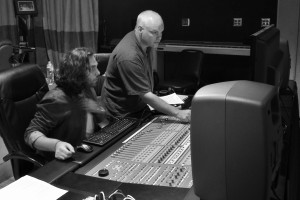
Engineer Nick Bonin and producer Ron Skinner in the control room of studio B at the recently reopened United Sound Systems Recording Studios. Photo by Jennifer Foulds.
United Sound Systems was founded by Jimmy Siracuse in the 1930s and has been in its current location, 5840 Second Avenue, since the early 1940s.
As one of the world’s first independent recording studios, United Sound Systems has a wonderfully rich history, serving artists from John Lee Hooker to Jackie Wilson, Bob Seger to MC5, The Rolling Stones to Aretha Franklin, Issac Hayes to Parliament-Funkadelic to Red Hot Chili Peppers. It was even used by Berry Gordy to record the very first Motown hits, before he built his own studio nearby.
In the beginning, Siracuse had opened his business primarily to create radio advertisements for the auto industry. At the time, ad agencies were springing up all around Detroit, and Siracuse, seeing a void, began offering high-quality recording services. But it is hard to doubt that Siracuse also recognized the unique music industry that was starting to grow in what was then America’s richest city.
Making Music History
The first significant piece of music history to be made at United Sound Systems came on December 21st, 1947 when Charlie Parker and his quintet recorded four sides for the Savoy label. It is this exact session date that we sought to recreate with the help of five wonderful Detroit musicians who we now call the Detroit Bop Quintet.
This 1947 recording date was significant for many reasons. It featured what seems to be the first internationally-famous recording artist to record at United Sound Systems. Even this is perhaps an understatement. Not only was the artist famous, he is easily one of the most influential musicians of the 20th century.
Charlie Parker and his Quintet were in Detroit performing their own sets, and backing Sarah Vaughn at the El Sino Club. The trip was a fourteen-day stretch that began on December 19th, 1947 and ended on January 1st, 1948. What brought Charlie Parker to Detroit in the dead of winter was something of a return engagement. It’s likely that if Parker had his way, he would have been anywhere else, rather than cold and snowy Detroit in December. But when an earlier booking at the El Sino went horribly wrong, Parker was obliged to return for a new concert.
As the story goes, during Parker’s prior visit, his vices got the better of him and he was not able to perform at the club as originally planned. This December visit was meant to make good on his promises to the El Sino. From what has been gathered in local Detroit folklore, Parker was at his peak while performing over this fourteen day stretch. His Quintet was made up of some pretty heavy players: a very young Miles Davis on trumpet, Max Roach on Drums, Tommy Potter on Bass and Duke Jordan on Piano.
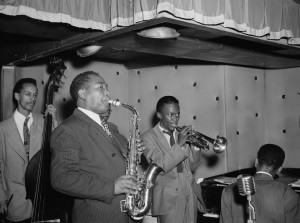
Tommy Potter, Charlie Parker, Max Roach (almost hidden by Parker), Miles Davis, and Duke Jordan, Three Deuces, New York, N.Y. October, 1947.
At this time in music history, recording sessions were generally reserved for cities like New York, Los Angeles and Chicago. So why then, would producer Teddy Reig take the chance of recording these sides in an unproven studio, and in the then unproven city of Detroit?
The answer lies in the fact that the musicians’ union was about to enact and enforce a ban of all commercial recording activities, to begin January 1st ,1948. It was meant to be a strike against the recording companies in an effort to increase the pay musicians would receive for their work. With the recording ban looming only ten days away, Savoy Records asked Reig to get Parker and his band in to the nearest studio to record a few sides.
United Sound Systems Recording Studio
What Reig, Parker, and his bandmates found when they entered United Sound Systems on the morning of December 21st, 1947 was one of the most sophisticated recording studios in the country.
Jimmy Siricuse had built the studio on Second Avenue in Detroit in a re-purposed two story home. The control room occupied what was once the front room, and the recording space was in what might have been the dining room. Siracuse, being a perfectionist, built his studio to exacting standards and utilized some of the most advanced acoustic treatments available at the time.
Poly-cylindrical diffusers lined the walls, in an effort to tune the room to acoustic perfection. The control room featured a state of the art mixer and acetate recorder, and the microphone cabinet was stocked with RCA ribbon mics, as well as the latest moving-coil technologies from local Michigan microphone manufacturer, Electro-Voice. United Sound Systems was not some second-rate studio in a backwater town after all. It was perhaps one of the best studios in the country at the time. It was built like all things in 1940s Detroit: To last.
While the 1947 Charlie Parker session may be the first international music success story to come out of United Sound Systems, it was definitely not the last. In its first incarnation, under the ownership of Jimmy Siracuse, United Sound Systems scored several international hits. Shortly after the 1947 Charlie Parker session, local Detroiter John Lee Hooker arrived and recorded his debut smash “Boogie Chillen”. In the early 1950’s United Sound Systems became home to Dizzy Gillespie’s Dee Gee Records, and in 1952 Jackie Wilson started his long list of hits recorded at United Sound Systems with “Danny Boy”.
In 1958, a young producer and label owner named Berry Gordy recorded the very first Motown sides at United Sound Systems. Then, like Siracuse before him, he bought a house a few blocks away and converted it to a recording studio. When the hits kept coming, Gordy used United Sound Systems as his second recording home.
If large orchestration was required, United Sound Systems’ newly built Studio A was the place to go in Detroit. Legendary orchestral sessions were tracked there by recording engineer Ed Wolfrum, including Marvin Gaye’s “What’s Going On”, and Isaac Hayes’ “Hot Buttered Soul” for the Stax label.
In 1971, guitarist and Motown producer Don Davis purchased United Sound Studios from Jimmy Siracuse, and the hits continued unabated. Hundreds of hit records were produced at United Sound Systems under Davis’ watch. In the 1970’s, George Clinton and Funkadelic basically moved in, calling Studio A their home for almost 20 years. The studio continued to thrive as the 1980’s saw the recording of seminal records by The Red Hot Chili Peppers and Aretha Franklin.
But by the mid-1990’s United Sound Systems, like much of Detroit, fell in to disrepair, and its doors were closed. Fortunately, in recent years, the studio has reemerged thanks to current owner, Danielle Scott. The doors have reopened, and a new era has begun at this historic space. With any luck, hits are sure to slowly begin trickling from this studio once again.
Analyzing the Charlie Parker Session
In all, four sides were recorded by Charlie Parker and his Quintet on December 21st, 1947 at United Sound Systems.
The first two, “Another Hair-Do” and “Bluebird” are simple blues tunes and the melodies of their head sections were most likely written by Parker on the spot. Each of these songs feature incredible solos by both Parker and Miles Davis.
The last two tunes are more like extended solos than they are “songs” as we know them in today’s sense. Both are performed with speed and agility over chord changes found in popular tunes of the day. The cut “Klaunstance” takes its changes from “The Way You Look Tonight” and “Bird Gets The Worm” from “Lover Come Back To Me”.
As was common in the 1940s, very little documentation was taken during the recording session. In fact, our research at TQM Recording Co. was only able to turn up a simple song cue sheet, indicating master takes.
Today, studio session notes and detailed recall sheets are often made of every piece of equipment used on almost every recording session. Each detail of even the most mundane recordings are kept as though the producers and engineers are creating history with each session. It seems that the musicians and producers of the 1940s didn’t realize, or didn’t care, that they were making history.
At the time of our recreation, both Jimmy Siracuse and his recording engineer son Joe had long since passed away. That meant that getting first-hand knowledge of how the recording was made was next to impossible. Thankfully, recording engineers share information amongst themselves and pass on wisdom from generation to generation, much like the oral histories of an ancient civilization. Luckily for TQM Recording Co., Detroit recording engineer extraordinaire Ed Wolfrum is still around to pass that information on to a new generation.
Ed Wolfrum started his career as a teenager working for local Detroit radio stations in the 1950s. He was a bit of a child prodigy when it came to electronics, and easily found work at an early age. Wolfrum may be best known for his invention of a tool we take for granted today: the direct box.
This little device, which converts instrument level signals to microphone level signals, had not yet been perfected when Wolfrum noticed the need and started selling his direct boxes to every recording studio and radio station in Detroit in the 1950s. His creation, then referred to as the “Wolfie Box”, was probably one of the most important ingredients in what we now call the “Detroit Sound”. The “Wolfie Box” provided the heavy bass tone of Funk Brother bass players James Jamerson and Bob Babbitt, and was used on almost every recording session in every studio in the Detroit area for several decades.
Wolfrum, previously a Motown recording engineer, took the job as head engineer at United Sound Systems in the 1960’s. Although Wolfrum’s time at United Sound Systems began years after the Parker/Davis session of 1947, he is able to speak about it as clearly as if he had been in the room himself.
Wolfrum remembers listening to a 15-ips tape copy of the session in the early 1960s, and fondly remembers talking to Jimmy and Joe Siracuse at length about the recording. Wolfrum believes that it was Joe Siracuse who most likely engineered the session. He recalls that Joe did all the jazz and blues sessions while his father Jimmy concentrated on the advertising work. This is an interesting insight, and runs counter to commercial releases of the record, which credit “Jim Siracusa” as engineer.
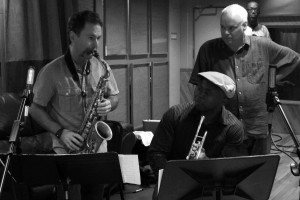
Pete Mills, Dwight Adams and Ron Skinner in United Sound System’s studio B. Photo by Jennifer Foulds.
Wolfrum describes the United Sound Systems Studio B as a beautifully designed space that was acoustically perfect. The musicians would have been set up in a circle looking at one another, with the piano placed against the wall, and the drums up on a small riser in the corner. The bass would be near the door, and Parker and Davis would have been in the center of the room facing the drummer. All the musicians would be within 5 feet of each other, all able to look directly at one another.
A maximum of 6 microphones would have been used on the session, but as few as four seems more likely. Intense scrutiny of the recording leaves one convinced that only a single microphone was used for both of the horn players. You can hear the movement of the musicians in and out of the microphone’s pickup pattern for solos and melodic harmonies.
On drums, the most likely choice would have been an Astatic Dynamic Omni or an Altec M-11 “Coke Bottle” microphone. “No kick drum microphone was used in that era” explains Wolfrum. For bass, the go-to was the RCA 44-BX, and the microphone would have been placed so that the null of the figure-eight pattern would eliminate drum bleed.
On piano, the choice was most likely to have been the Altec 639 Dynamic-Ribbon “Bird Cage” microphone, set on “wide”. And for horns, the mics would have been dynamics, most likely an Electro-Voice 655 omni dynamic, or one of the many Electro-Voice prototypes that United Sound Systems was given to test by E.V. founder Lou Burroughs.
As TQM Recording Co. embarked on the journey of recreating this beautifully-recorded session almost 70 years after the original, Ed Wolfrum recalled his memory of how they worked at United Sound Systems in Detroit: “The first rule at United was ‘make the musicians comfortable.’ We never used headphones on a rhythm date. Jimmy said it ruins the natural balance. The guys always faced one another for eye contact and feel, and we never used baffles.”
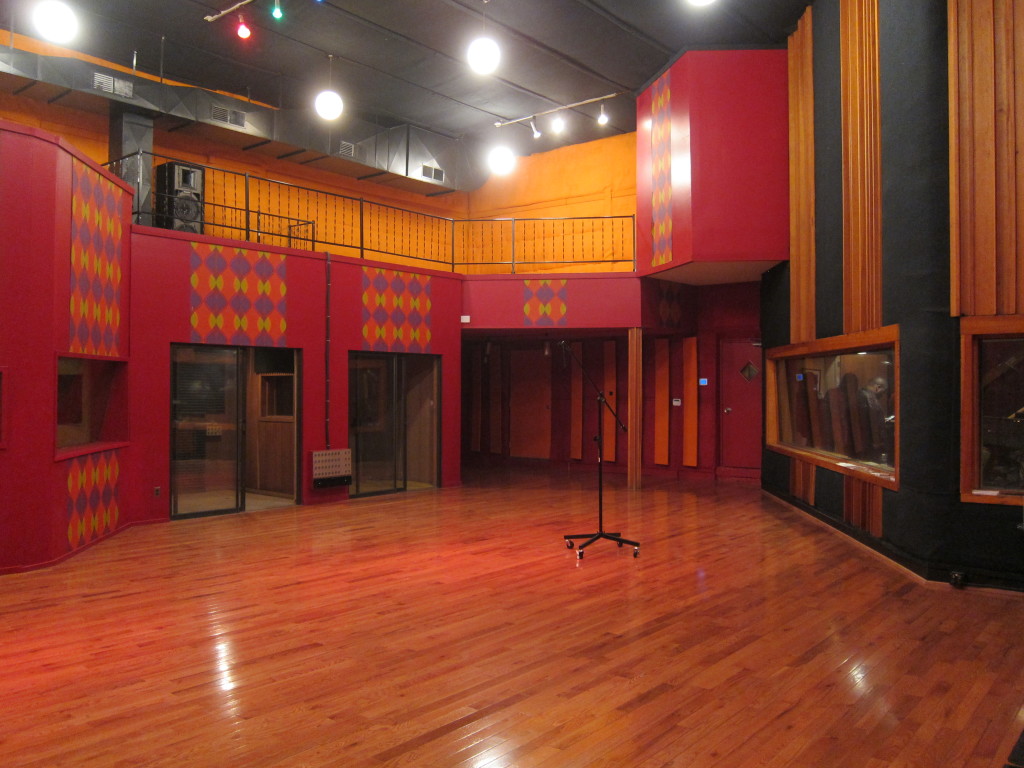
A view of the restored A room at United Sound Systems. A larger cousin to the studio B, which was used for this session.
The Detroit Bop Quintet
The Detroit Bop Quintet was assembled specifically for this United Sound Systems session in Detroit. The band is made up of four of Detroit’s best Jazz musicians, and a saxophonist from Columbus, Ohio who says he is proud to be considered an honorary Detroiter for the session.
The Detroit Bop Quintet is: Dwight Adams – Trumpet, Pete Mills – Saxophone, Rick Roe – Piano, Paul Keller – Bass and Nate Winn – Drums.
Session Goal
The goal of TQM Recording Co’s August 18th, 2014 session at United Sound Systems was simple. We sought to answer one very hard question: Is it still possible to recreate the sound and feel of a classic Jazz recording in modern times?
The original session held on December 21st, 1947, was produced by legendary producer Teddy Reig and engineered either by Jimmy Siracuse or his son Joe Siracuse.
The musicians on the session were all astonishing ones, still famous today, and together they were breaking new ground with every performance and recording. Charlie Parker was the session leader and played alto saxophone, a young Miles Davis was on trumpet and the legendary Max Roach was on Drums. On piano and bass were two musicians that may not be as famous, but were every bit as good: Duke Jordan and Tommy Potter.
When listening to classic recordings like the 1947 Charlie Parker session at United Sound Systems, the first reaction is often disbelief. This is especially true if you are familiar with the tools that the recording engineers and producers had at their disposal at the time.
Setting Up The Session
To effectively recreate a 70-year-old recording session, it is important to always keep the basic goal in mind. It was essential that our session be recorded with as little technology as possible, and the technology we did use needed to be thoughtfully chosen. Having said that, this isn’t 1947. So many incredible tools available to us and it would be foolish not to use them where appropriate.
Leading up to the day of the session were weeks worth of research and preparation. Because there was little or no official documentation, no written technical details and no photographs, we had to rely mostly on oral histories of the session, and information about the normal approaches at United Sound Systems. Savoy Records, the original label, had nothing more than a hand-typed take log noting completed takes, false starts, and which of the completed takes should be considered the master take. Because producer Teddy Reig, engineers Jimmy and Joe Siracuse, and all the session’s musicians have passed away, first hand accounts were next to impossible.
The sound of any live session is very much dependent on the room’s acoustics and the location of each musician in relation to one another. It is the room and the bleed of adjacent instruments into other instruments’ close mics that form this special ingredient. This meant that finding out where the musicians were placed in the studio was essential knowledge. Luckily, recording engineers are often creatures of habit, and when they find something that works, they tend to stick with it.
When Ed Wolfrum was an engineer at United Sound Systems, he remembered that Studio B had become primarily a foley and film sound overdub room. By the 1960s, most of the music sessions took place in United Sound System’s new and gigantic Studio A. But in 1947, Studio B was the only studio space at United Sound Systems. (However, Wolfrum does mention that because Studio B was so ideal for small jazz combos, it was often used for jazz recordings well in to the 1980’s.)
The two key pieces of the puzzle around where the musicians were located came from the placement of the piano and the drums. Ed Wolfrum easily remembered the set up of Studio B in this regard: “Drums were always on the raised section of the room in the Northeast corner. Piano was on the south wall. I moved it out from the wall on the few dates I did there. Parker and Davis were most likely facing them diagonally.”
With this description of Studio B, plus the knowledge that the drums were always placed on the riser and the piano was always against the adjacent wall, TQM Recording Co. could easily deduce the rest of the set up.
- Pete Mills of the Detroit Bop Quintet.
- Paul Keller of the Detroit Bop Quintet.
- Nate Winn of the Detroit Bop Quintet.
- Dwight Adams of the Detroit Bop Quintet.
- Rick Roe of the Detroit Bop Quintet.
- The Detroit Bop Quintet outside the recently restored United Sound Systems in Detroit. All photos in this series by Reggie Tiessen.
The Gear
After the musicians, the room, and the engineer are taken into account, the most important pieces of equipment on any recording session are undoubtedly the microphones.
For this session, choosing the right microphones was especially crucial. In 1947, when the original session was recorded, the microphone did practically all of the work. Mixing consoles of that era did not come equipped with equalizers and compressors, so the signal path would have been fairly simple: Microphone, mixer, limiter, acetate lathe.
The choice of available microphones would also have been quite limited as well. The most common mics of the era were American-made ribbons and dynamics. In 1947, very few condenser microphones were available, especially in the outside of Germany, where they had recently been invented. The most most common condenser microphones in the US at this time were made by Altec, while ribbon microphones would have been Altec or RCA. Due to Detroit’s geographical proximity to the Electro-Voice factory, the EV dynamics were most likely in heavy use at United Sound Systems.
After much research, the following microphones were finally chosen for the recreated session:
Bass Drum: AKG D-12 VR Dynamic
Drum Overhead: AKG C-12 VR Tube Condenser, Omni
Bass: RCA 44-BX Ribbon
Piano: Royer 122 Ribbon
Saxophone: Mesanovic Model 2 Ribbon
Trumpet: Mesanovic Model 2 Ribbon
Room: Two Neumann U-87 Condensers, Omni
A total of 10 microphones were used on the session. This is as many as four more than would have been present during the original session. But the real reason for the extra microphones on this session was simple: It is because we could.
While we wanted to recreate the session as closely as possible, we also wanted the recording to be modern. We were after a particular sound and feel, and not necessarily a perfect historical re-enactment. Using fewer microphones would be like asking the musicians to solo exactly as the original players did on the original recordings—which would not be keeping true to the conception of jazz as an improvised art form.
The ribbon mics we used on the horns were graciously provided by Deni Mesanovic of Mesanovic Microphones. These microphones are hand-built in Detroit, and being able to get a Detroit microphone manufacturer involved in the session was a cool bit of luck.
The RCA 44-BX was provided by Ed Wolfrum. His interest in our session was amazing and his help, invaluable. When a tube condenser microphone was suggested for the bass, Wolfrum quickly pointed out the error: “I would question the condenser on the bass as the bi-directional, high frequency nulls on a condenser microphone with 2 capsules are not as good, off-axis, as a single ribbon is. This may present a problem with the cymbals bleeding into the bass.”
There were a couple of other places where TQM Recording Co. deviated from the 1947 microphone set up: The addition of a bass drum microphone was, again, to keep the sound of our session modern. The more controversial decision was to add the two room microphones.
According to Ed Wolfrum, room microphones were never used at United Sound Systems: “We NEVER used room mikes…NEVER. I can’t understand where that concept ever came from.”
This is a sentiment we could agree with, but in this case, room microphones were absolutely essential for a specific reason: Not knowing the exact location of the musicians in the room (or the exact microphone techniques) meant these room mics would give us extra flexibility in getting as close as possible to the sound and feel of the original recording.
Having some spaced room microphones set to an omnidirectional pattern would be very helpful if extra acoustic room ambience was needed to match the tone of the original session. As it turned out, that decision was a good one, and a small amount of the signal from the room microphones needed to be blended in to increase the sound of the room in the final mix.
As for other equipment used on the recording session, it was kept simple, and the available gear found today in United Sound Systems Studio B was used. The capture device was decidedly more modern than an acetate recorder: Focusrite microphone pre-amplifiers were used for all microphone channels, and Avid ProTools 10 was used as the recorder with Avid 192 I/O as the audio interface. The session was recorded at a sample rate of 96kHz at 24 bits.
Mixing and Mastering
The mix and mastering sessions were done at my and TQM Recording Co’s home base: Heading North Mastering in Toronto.
The main mix of the session is a mono version, and all processing was be kept to a minimum. The mixing console used was an Avid System 5 all-digital console, running at 96kHz. All compression was done in the analog domain, and equalization was a combination of analog and digital.
Here is a list of analog gear used on the mix:
Universal Audio 2-1176: Bass drum and drum overhead
Smart Research C2: Room microphones
Manley Labs Massive Passive and Vari-Mu: Bass and piano
Avalon AD2044 and AD2055: Horns
For the mastering session, the Manley Massive Passive Equalizer and Vari-Mu Compressor were used on the mono and stereo mixes along with a Studer A-810 1/4-inch tape machine.
Further compression and limiting were done in the digital domain with the iZotope Ozone 5 mastering suite. For the 5.1 surround mix, all mastering processing was done with Ozone 5.
The DAW used for the mix was once again ProTools 10, while Sadie 6 was used as the mastering DAW.
The vinyl lacquer was cut at Ardent Studios in Memphis on the legendary Stax records lathe by Jeff Powell.
The Final Result
The telling moment in the session came on the first listen with the microphones all in place and the musicians assembled on the studio floor the band started to rehearse. The sound of the room was perfect, and the tone of the instruments and how they interacted with each other was startlingly close to the original recordings.
The first playback was also a revelation for the musicians. They had become quite familiar with the original recordings in their preparation for the session, and when they heard their first take played back on the studio monitors, the musicians seemed just as impressed as the recording crew.
When it came time for the final mixdown, very little was needed in terms of equalization and compression. Getting a proper balance between the instruments and adding the right amount of additional room signal was all it took to re-create the general tone of the original session.

The final results are available in many forms, but in my opinion, the best way to listen is on the vinyl. While it would have been cool to press the session onto 10” 78-rpm discs like the original release, that would prove to be impractical with no significant pressing plants still producing the format. The best available way to get close to the original reproduction was with the 7” 45 rpm single format, and that is the primary release format for the project.
Of course, this being 2015, digital files are also available. The main digital release to iTunes and other online retailers is the mono mixes. For those more adventurous listeners, mono and stereo mixes have been combined for sale as a digital album, at http://www.TQMRecordingCo.com and high resolution 5.1 mixes are also available on the site.
Ron Skinner is an audio engineer who runs Heading North Mastering in Toronto, as well as the record label TQM Recording Co.

Please note: When you buy products through links on this page, we may earn an affiliate commission.







